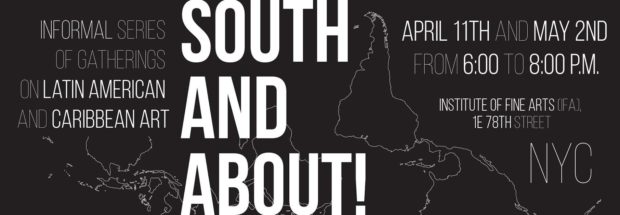South and About! Spring 2017

April 11
Performing Exile: An Interrogation of Hélio Oiticica’s work in New York City
Gwen Unger, PhD Candidate in Art History, Columbia University
Abstract:
In this paper I examine the seventies as a period of exile for Brazilian artists through an interrogation of Hélio Oiticica’s work and practice during his time in London and New York City. For this examination I situate the 1970’s as beginning in 1968 for Oiticica, with the passing of the Ato Institucional Número Cinco, also known as AI-5, which greatly censored and restricted artistic practice in Brazil. Embarking from his seminal work, Tropicália, I intend to demonstrate how Oiticica’s work and artistic practice performs his identity as exiled. I hope to demonstrate how Tropicália and the udigrudi [underground] counter-culture of the Brazilian avant-garde is in fact an exile-culture. Oiticica’s work readily blurred the line between art and life, demonstrating that the performance of exile was never relegated to either sphere exclusively. In this sense his work connects to the reaction to pop and minimalism of the 1960’s avant-garde; Oiticica in fact decries what he calls the “aesthetic de-aestheticization” of the New York avant-garde, and attempts to distance himself from this specifically American discourse of postmodernism. In his attempts to separate and distance himself, I believe Oiticica further performs and stresses his Brazilian identity and exile. Additionally, I believe that the exploration of space in Oiticica’s work demonstrates an attempt to re-assert identity and citizenship as Brazilian in his experience of exile.
–
Photographing Modernist Caracas, from Synthesis to Synthetic
Sean Nesselrode Moncada, PhD candidate in Art History, IFA-NYU
Abstract:
As midcentury Caracas experienced a process of rapid, vertiginous urbanization, photography emerged as a medium by which the city’s spectacular building projects could not only be depicted but also critiqued. This talk looks at the work of Paolo Gasparini, Daniel González, and Bárbara Brändli in the 1960s and 1970s, which moves from depictions of abstraction to those of alienation, ultimately establishing a counter-imagery of urban life: that of the mannequin as symbol an artificial and ultimately inhuman mode of being.
—
May 1
Painting after the End of History
María Fernanda Domínguez, M.A. Candidate in Art History, IFA-NYU
Abstract:
How did preexisting photographic cultures challenge the canonical practice of painting in the nineteenth century? The question is particularly relevant in a context like Colombia where photography (1840) preceded the foundation of an official academy of arts (1886) for decades. Is it possible, then, to consider the development of painting independently from the appearance of a photographic realm that overlaps with it?
This research into the life and work of Epifanio Garay (1849-1903), one of the most distinguished painters in nineteenth-century Colombia, aims to address these questions. Although he is best known as a painter, Garay also worked extensively with photography. I would like to reconsider his practice in a postcolonial context and within a framework of overlapping visual technologies. In doing so, I hope to approach photography no longer as a expedient aid for painting from life but rather as an inevitable aspect of the visual — one that coexists with painting. The purpose of my research is to address the promiscuous relationship between Garay’s painting and mechanically reproduced images. I propose that a pre-existing photographic culture, acts as an intermediary, complicating the intersection between colonial copies and naturalism.

